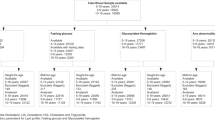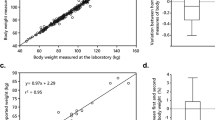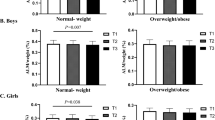Abstract
OBJECTIVE: The main objective of the study was to examine the effect of early life malnutrition on the relation between insulin sensitivity and abdominal adiposity in adulthood. It was hypothesised that participants with early life malnutrition would display a more pronounced deterioration of insulin sensitivity in association with a gain in abdominal fat.
DESIGN: As a first attempt to investigate this issue, we studied the effect of body fat gains in a cross-sectional context.
SUBJECTS: A total of 26 young adult men with evidence of malnutrition during the first year of life and 27 control subjects were recruited for this study. Malnutrition status was determined from medical files of paediatric hospitals in the Mexico City metropolitan area.
MEASUREMENTS: Insulin sensitivity was measured by hyperinsulinaemic euglycaemic clamp, and body composition was measured by anthropometrics, bioelectrical impedance and computed tomography.
RESULTS: There was a negative correlation between total abdominal adipose tissue area and insulin sensitivity in the previously malnourished and control groups (r2=0.65 and 0.35, P<0.01, respectively). When matched for low amounts of abdominal fat (114 cm2), participants with and without early life malnutrition had similar insulin sensitivity (9.03 vs 8.88 mg kg−1 min−1). However, when matched for high amounts of abdominal fat (310 cm2) participants who were malnourished during the first year of life had lower insulin sensitivity (4.74 vs 6.85 mg kg−1 min−1, P<0.05).
CONCLUSION: Higher levels of abdominal adipose tissue are more detrimental to insulin sensitivity in previously malnourished individuals.
This is a preview of subscription content, access via your institution
Access options
Subscribe to this journal
Receive 12 print issues and online access
$259.00 per year
only $21.58 per issue
Buy this article
- Purchase on Springer Link
- Instant access to full article PDF
Prices may be subject to local taxes which are calculated during checkout


Similar content being viewed by others
References
Garnett SP, Cowell CT, Baur LA, Fay RA, Lee J, Coakley J, Peat JK, Boulton TJ . Abdominal fat and birth size in healthy prepubertal children. Int J Obes Relat Metab Disord 2001; 25: 1667–1673.
Ravelli GP, Stein ZA, Susser MW . Obesity in young men after famine exposure in utero and early infancy. N Engl J Med 1976; 295: 349–353.
Flanagan DE, Moore VM, Godsland IF, Cockington RA, Robinson JS, Phillips DI . Fetal growth and the physiological control of glucose tolerance in adults: a minimal model analysis. Am J Physiol 2000; 278: E700–E706.
Phillips DI, Barker DJ, Hales CN, Hirst S, Osmond C . Thinness at birth and insulin resistance in adult life. Diabetologia 1994; 37: 150–154.
Hales CN, Barker DJ, Clark PM, Cox LJ, Fall C, Osmond C, Winter PD . Fetal and infant growth and impaired glucose tolerance at age 64. BMJ 1991; 303: 1019–1022.
Barker DJ, Hales CN, Fall CH, Osmond C, Phipps K, Clark PM . Type 2 (non-insulin-dependent) diabetes mellitus, hypertension and hyperlipidaemia (syndrome X): relation to reduced fetal growth. Diabetologia 1993; 36: 62–67.
Robinson S, Walton RJ, Clark PM, Barker DJ, Hales CN, Osmond C . The relation of fetal growth to plasma glucose in young men. Diabetologia 1992; 35: 444–446.
Cook JT, Levy JC, Page RC, Shaw JA, Hattersley AT, Turner RC . Association of low birth weight with beta cell function in the adult first degree relatives of non-insulin dependent diabetic subjects. BMJ 1993; 306: 302–306.
Jaquet D, Gaboriau A, Czernichow P, Levy-Marchal C . Insulin resistance early in adulthood in subjects born with intrauterine growth retardation. J Clin Endocrinol Metab 2000; 85: 1401–1406.
Leger J, Levy-Marchal C, Bloch J, Pinet A, Chevenne D, Porquet D, Collin D, Czernichow P . Reduced final height and indications for insulin resistance in 20 year olds born small for gestational age: regional cohort study. BMJ 1997; 315: 341–347.
Hales CN, Barker DJ . Type 2 (non-insulin-dependent) diabetes mellitus: the thrifty phenotype hypothesis. Diabetologia 1992; 35: 595–601.
Zimmet PZ, McCarty DJ, de Courten MP . The global epidemiology of non-insulin-dependent diabetes mellitus and the metabolic syndrome. J Diabetes Complications 1997; 11: 60–68.
Fujimoto WY . Overview of non-insulin-dependent diabetes mellitus (NIDDM) in different population groups. Diabet Med 1996; 13: S7–S10.
Després JP . Abdominal obesity as important component of insulin-resistance syndrome. Nutrition 1993; 9: 452–459.
Gomez F, Ramos GR, Frenk S, Cravioto MJ, Chavez R, Vazquez J . Mortality in second and third degree malnutrition. J Trop Pediatr 1956; 2: 77–83.
Rizza RA, Mandarino LJ, Gerich JE . Dose–response characteristics for effects of insulin on production and utilization of glucose in man. Am J Physiol 1981; 240: E630–E639.
Ravussin E, Valencia ME, Esparza J, Bennett PH, Schulz LO . Effects of a traditional lifestyle on obesity in Pima Indians. Diabetes Care 1994; 17: 1067–1074.
Bennett PH . Type 2 diabetes among the Pima Indians of Arizona: an epidemic attributable to environmental change? Nutr Rev 1999; 57: S51–S54.
Bavdekar A, Yajnik CS, Fall CH, Bapat S, Pandit AN, Deshpande V, Bhave S, Kellingray SD, Joglekar C . Insulin resistance syndrome in 8-year-old Indian children: small at birth, big at 8 years, or both? Diabetes 1999; 48: 2422–2429.
Godfrey KM, Barker DJ . Maternal nutrition in relation to fetal and placental growth. Eur J Obstet Gynecol Reprod Biol 1995; 61: 15–22.
Quibrera IR, Hernández RHG, Aradillas GT, González RC, Calles-Escandón J . Prevalencias de diabetes, intolerancia a la glucosa, hiperlipemia y factores de riesgo en función de nivel socioeconómico. Rev Invest Clin 1994; 46: 25–36.
Holness MJ, Sugden MC . Antecedent protein restriction exacerbates development of impaired insulin action after high-fat feeding. Am J Physiol 1999; 276: E85–E93.
Ozanne SE, Nave BT, Wang CL, Shepherd PR, Prins J, Smith GD . Poor fetal nutrition causes long-term changes in expression of insulin signaling components in adipocytes. Am J Physiol 1997; 273: E46–E51.
Brook CG . Evidence for a sensitive period in adipose-cell replication in man. Lancet 1972; 2: 624–627.
Weyer C, Foley JE, Bogardus C, Tataranni PA, Pratley RE . Enlarged subcutaneous abdominal adipocyte size, but not obesity itself, predicts type II diabetes independent of insulin resistance. Diabetologia 2000; 43: 1498–1506.
Acknowledgements
This study was supported by a grant from the Nestlé Foundation. Mr Boulé is supported by NSERC of Canada postgraduate scholarship. We acknowledge the contribution of the following institutions in Mexico City for the recruitment of participants: Instituto Nacional de Pediatra, Hospital General, Centro Infantil de Rehabilitacion Nutricional, and Hospital Infantil Frederico Gomez.
Author information
Authors and Affiliations
Corresponding author
Rights and permissions
About this article
Cite this article
Boulé, N., Tremblay, A., Gonzalez-Barranco, J. et al. Insulin resistance and abdominal adiposity in young men with documented malnutrition during the first year of life. Int J Obes 27, 598–604 (2003). https://doi.org/10.1038/sj.ijo.0802288
Received:
Revised:
Accepted:
Published:
Issue Date:
DOI: https://doi.org/10.1038/sj.ijo.0802288
Keywords
This article is cited by
-
Impact of prenatal famine exposure on adulthood fasting blood glucose level
Scientific Reports (2022)
-
The body mass index is a less-sensitive tool for detecting cases with obesity-associated co-morbidities in short stature subjects
International Journal of Obesity (2004)



